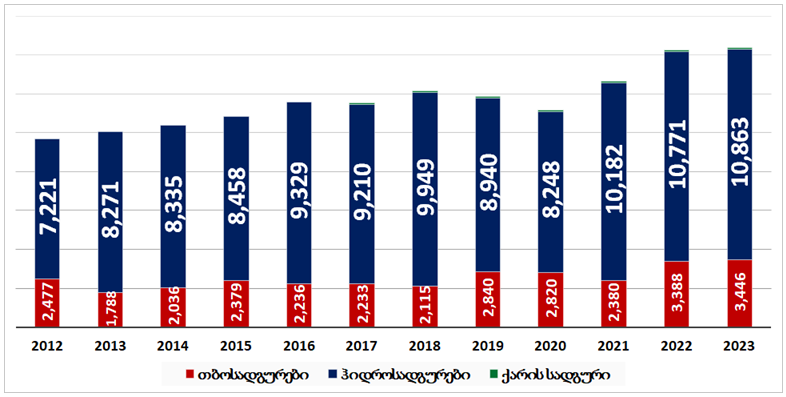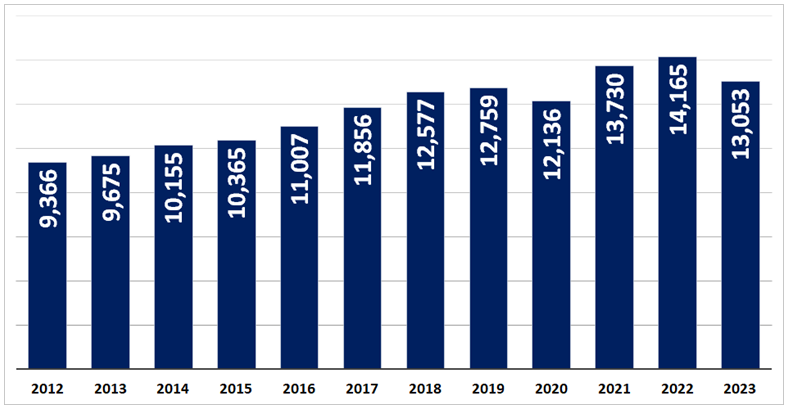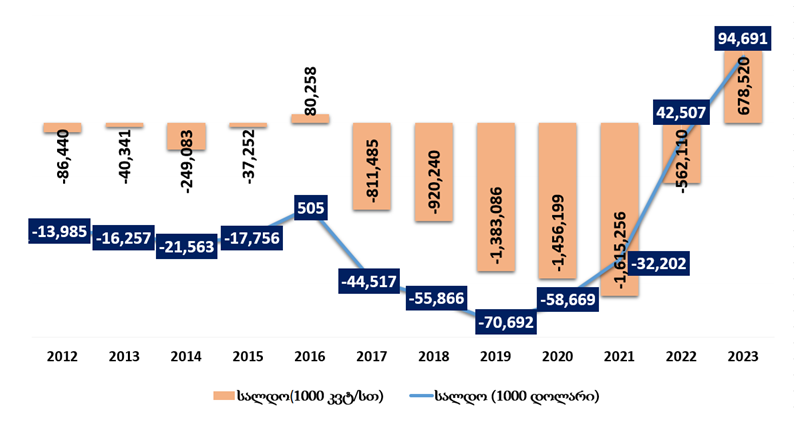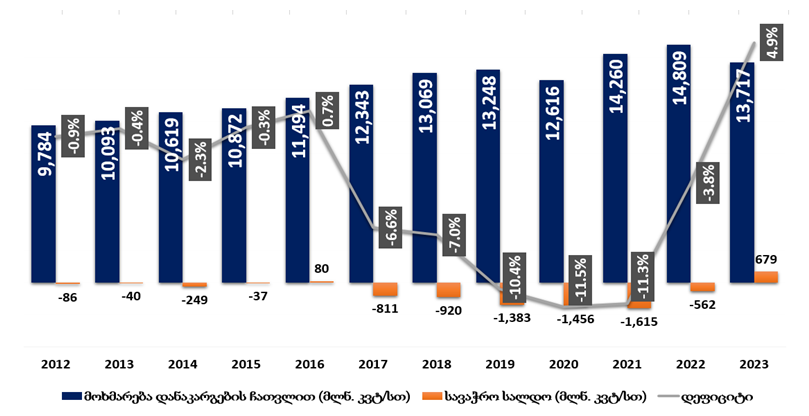Levan Davitashvili: “Electricity generation is increasing annually.”
Verdict: FactCheck concludes that Levan Davitashvili’s statement is MOSTLY TRUE.
Electricity generation constituted 9.7 billion kWh in 2012, increasing to 14.4 billion kWh in 2023, marking a 48% rise. Thermal and hydroelectric power generation grew by 39% and 50%, respectively, in the aforementioned period. Despite the operation of a wind power plant since late 2016, its share in total energy generation remains below 1%. Two large thermal power plants and several small to medium-sized hydroelectric stations have been constructed over the past 11 years.
Energy consumption has also grown at a similar pace. Whilst energy supplied to consumers amounted to 9.4 billion kWh in 2012, it totalled 13.1 billion kWh in 2023, indicating a 39% rise. Energy usage was even higher at 14.2 billion kWh in 2022 which is 51% higher as compared to the 2012 data. The decrease in energy consumption in 2023 was due to reduced demand from large factories, crypto mining and occupied Abkhazia.
Electricity exports totalled USD 343 million (6.7 billion kWh) and imports amounted to USD 523 million (13 million kWh) from 2013 to 2023. The negative trade balance constituted USD 180 million, equivalent to 6.3 billion kWh. Trade balances were only positive in 2016 and 2023. Moreover, the monetary balance was positive whilst the net volume remained negative in 2022.
Despite the increase in electricity generation and the construction of new plants, consumption has also grown, leading to imports always exceeding exports both monetarily and by volume. The annual deficit exceeded USD 50 million and 1.1 billion kWh, accounting for 8.5% of total consumption, from 2017 to 2022.
Furthermore, despite the pledges, the Khudoni, Nenskra, Namakhvani, Tskhenistskali and Oni hydro power plants were not constructed. Additionally, no wind (aside from one wind plant) or solar power plants have been built. Electricity generation would have increased at a much higher rate had half of these projects been implemented which would likely eliminate or significantly reduce the deficit. The Minister of Economy and Sustainable Development highlighted only one aspect of the story – the increase in production – but omitted the rise in consumption and the persistent deficit. Considering all the above, FactCheck concludes that Levan Davitashvili’s statement is MOSTLY TRUE.
Analysis
During his speech on the Professional Day of Energy Workers, Levan Davitashvili, the Minister of Economy and Sustainable Development, stated: “The number of power-generating stations in Georgia increases annually, along with the installed capacity and the volume of generated electricity.”
The two primary sources of electricity generation in Georgia are hydroelectric power plants, accounting for 80% of total production, and thermal power plants. The share of wind power plants in total energy generation remains below 1%. Furthermore, several solar micro power plants are not even listed in the State Electrosystem.
The exploitation of the Gardabani 1 and Gardabani 2 thermal power plants, as well as the Shuakhevi, Paravani, Larsi, Matchakhela, Khelvachauri hydroelectric power plants, along with other smaller-scale hydro power plants (capacities under 13 MWh) commenced under the governance of the Georgian Dream political party.
Hydroelectric generation constituted 7.2 billion kWh, whilst thermal generation reached 2.5 billion kWh, totalling 9.7 billion kWh in 2012. Hydro generation had increased to 10.9 billion kWh, thermal generation amounted to 3.4 billion kWh and wind power plants generated 86 million kWh, bringing the total electricity production to 14.4 billion kWh in 2023. The data indicates that total production increased by 48% over the 11-year period.
It should also be noted that, in addition to the number of plants, climate plays a crucial role in the production capacity of hydroelectric stations. River flow levels vary each year which directly affects the volume of electricity generated. For instance, whilst hydro electricity production amounted to 9.4 billion kWh in 2010, it had decreased to 7.2 billion kWh in 2012, marking a 23% reduction. Furthermore, the technical condition of operating hydroelectric stations, especially the Enguri Dam, also significantly impacts total electricity generation.
Graph 1: Electricity Generation (Million kWh)

Source: Georgian State Electrosystem
The wind power station, which has been operating since late 2016, is barely visible on the graph above. It has been consistently generating 83-91 million kWh electricity and accounting for 0.6%-0.8% of total production from 2017 to 2023.
Electricity generation consistently increased from 2013 to 2016 and remained relatively stable in 2016-2019. Generation decreased in 2020, followed by a rise from 2021 to 2023. Whilst demand also fell in 2020 due to the pandemic, this was not the primary reason for the reduction in generation. The electricity produced by the Enguri Dam is the cheapest with costs less than GEL 0.02 per kWh. It generated 3.3 billion kWh of electricity in 2019, decreasing by 600 million kWh to 2.7 billion kWh in 2020. If necessary, savings would have been made at the expense of thermal plants rather than the Enguri Dam.
The State Electrosystem has released the data from the first seven months of 2024 which indicates that the total electricity generation has increased from 8.6 billion kWh to 8.9 billion kWh as compared to the same period last year.
Additionally, electricity consumption also grew by 39%, rising from 9.4 billion kWh in 2012 to 13.1 billion kWh in 2023. Energy usage peaked in 2022 at 14.2 billion kWh. The decrease in energy consumption in 2023 was due to reduced demand from large factories, crypto mining and occupied Abkhazia. Overall, electricity consumption increased by 51% from 2012 to 2022.
Graph 2: Electricity Consumption (Million kWh)

Source: Georgian State Electrosystem
Overall, electricity consumption has been experiencing an upward trajectory with the decline in 2023 being only a temporary exception. Rising prices for ferroalloys and bitcoin will likely drive further growth in electricity usage. Electricity consumption has already increased by 4.5% in January-July of 2024 as compared to the same period in 2023, rising from 7.7 billion kWh to 8 billion kWh.
Electricity exports totalled USD 343 million (6.7 billion kWh) and imports amounted to USD 523 million (13 million kWh) from 2013 to 2023. Negative trade balance constituted USD 180 million, equivalent to 6.3 billion kWh. Trade balances were only positive in 2016 and 2023. Moreover, the monetary balance was positive in 2022 due to the increased demand from occupied Abkhazia. Whilst the trade balance is positive in the eight months of 2024, it is still challenging to make definitive conclusions without accounting for the seasonal effects in the winter months when imports rise and exports are practically zero.
Graph 3: Electricity Trade Balance

Source: National Statistics Office of Georgia
The deficit in total consumption (including losses) constituted 0.7% from 2012 to 2016, increasing to 8.5% from 2017 to 2022. The deficit totalled 11.1% in 2019-2021.
Graph 4: Electricity Deficit in Total Consumption

Source: Georgian State Electrosystem, National Statistics Office of Georgia
Despite the increase in electricity generation and the construction of new plants, consumption has also grown, leading to imports always exceeding exports both monetarily and by volume. The annual deficit exceeded USD 50 million and 1.1 billion kWh, accounting for 8.5% of total consumption, from 2017 to 2022. The surplus in 2023 was primarily driven by the decline in consumption rather than an increase in generation.
Furthermore, despite the pledges, the Khudoni, Nenskra, Namakhvani, Tskhenistskali and Oni hydro power plants were not constructed. Additionally, no wind (aside from one wind plant) or solar power plants have been built. Electricity generation would have increased at a much higher rate had half of these projects been implemented which would likely eliminate or significantly reduce the deficit. The Minister of Economy and Sustainable Development highlighted only one aspect of the story – the increase in production – but omitted the rise in consumption and the persistent deficit. Considering all the above, FactCheck concludes that Levan Davitashvili’s statement is MOSTLY TRUE.








